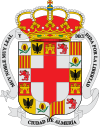Almería
| Almería | |||
|---|---|---|---|
 |
|||
|
|||
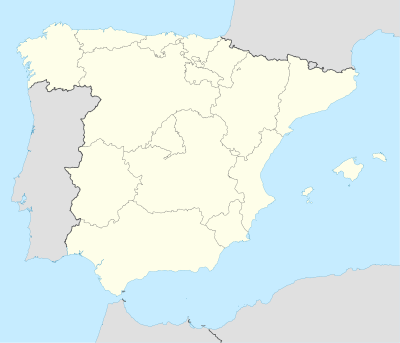 Almería
|
|||
| Coordinates: | |||
| Country | Spain | ||
| Community | Andalusia | ||
| Comarca | Comarca Metropolitana de Almería | ||
| Government | |||
| - Mayor | Luis Rogelio Rodríguez-Comendador Pérez (PP) | ||
| Area | |||
| - Total | 295 km2 (113.9 sq mi) | ||
| Elevation | 23 m (75 ft) | ||
| Population (2009) | |||
| - Total | 188,810 | ||
| - Density | 640/km2 (1,657.7/sq mi) | ||
| Demonym | Almerienses | ||
| Time zone | CET (UTC+1) | ||
| - Summer (DST) | CEST (UTC+2) | ||
Almería is the capital of the province of Almería, Spain. It is located in south-eastern Spain on the Mediterranean Sea.
Contents |
History
The name "Almería" stems from Arabic المرية Al-Mariyya: "The Mirror", comparing it to "The Mirror of the Sea".
The city was founded by caliph Abd ar-Rahman III of Cordova, in 955, as a principal harbour in his extensive domain to strengthen his Mediterranean defences.
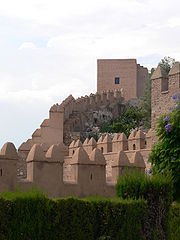
Its Moorish castle, Alcazaba, is the second largest among the Muslim fortresses of Andalusia after the Alhambra.
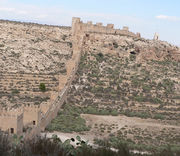
In this period the port city of Almería reached its historical peak, continuing, after the fragmentation of the Caliphate of Cordova, under powerful local Muslim taifa emirs like Jairan, the first independent Emir of Almería and Cartagena and Almotacin, the poet emir, both fearless warriors but also patrons of the arts. A silk industry, based upon plantings of mulberry trees in the hot dry landscape of the province, supported Almería in the 11th century and made its strategic harbour an even more valuable asset. Contested by the emirs of Granada and Valencia, Almería experienced many sieges, including one especially fierce one when Christians, called to the Second Crusade by Pope Eugene III, were also encouraged to attack the Muslim 'infidels' on a more familiar coast.
On that occasion Alfonso VII, at the head of mixed forces of Catalans, Genoese, Pisans and Franks led a crusade against the rich city, and Almería was occupied in October 1147. Within a decade it had passed to the control of the puritanical Almoravid emirs,and not until the late 15th century did it fall permanently into Christian hands. The city surrendered to the Catholic Monarchs, Ferdinand and Isabella, on December 26, 1489.

The 16th century was for Almería a century of natural and human catastrophes; for there were at least four earthquakes; of which the one in 1522 was especially violent, devastating the city. The people who had remained Muslim were expelled from Almería after the War of Las Alpujarras in 1568 and scattered across Spain. Landings and attacks by Berber pirates were also frequent in the 16th century, and continued until the early 18th century. At that time, huge iron mines were discovered and French and British companies set up business in the area, bringing renewed prosperity and returning Almería to a position of relative importance within Spain.
During the Spanish Civil War the city was shelled by the German navy, and the front page headlines of the Diario de Almería, dated June 3, 1937, referred to the press in London and Paris carrying the news of the "criminal bombardment of Almería by German planes".[1] It and Málaga were the last Andalusian cities to surrender to Francisco Franco's "National Spain" forces.
In the second half of the 20th century, Almería witnessed spectacular economic growth due to tourism and intensive agriculture, with plants grown year-round in massive 'invernaderos' - plastic-covered "greenhouses" - for intensive vegetable production.
After Franco's death and the approval of the new Spanish Constitution, the people of southern Spain were called on to approve an autonomous status for the region in a referendum. The province of Almería voted in favour of it and joined the newly created autonomous region of Andalusia, with 118,186 votes for and 11,092 votes against.[2]
Main sights
- The Alcazaba, a medieval fortress that was begun in the 13th century but destroyed by an earthquake in 1522. It includes a triple line of walls, a majestic keep and large gardens. It commands a quarter in white colours, of Muslim-age aspect.
- The Cathedral, has a fortress-like appearance due to its towers, merlons and protected paths, created to defend it from Mediterranean pirates. Originally designated as a mosque it was later converted into a Christian church, before being destroyed in the 1522 earthquake. In the 16th century it was rebuilt in the Renaissance style, whilst keeping some of its defensive features.
- Renaissance church of Santiago, built in 1533, with tower and portal decorated with reliefs.
- Chanca, a group of houses carved into rocks.
- Castle of San Cristobal, now in ruins. It is connected to the Alcazaba by a line of walls.
- Museum of Almería. Includes findings from Prehistoric, Iberic, Roman, Greek ages and Muslim objects, mostly from the Alcazaba.
- Paseo de Coches, a modern seaside promenade with gardens and palms.
Demographics
Source: INE (Spain)
People and culture
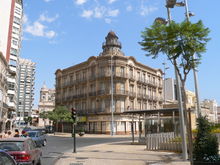
Famous natives of Almería include Nicolás Salmerón, who in 1873 was the third president of the First Spanish Republic, and several musicians, like the popular folk singer Manolo Escobar, renowned Flamenco guitar player José Tomás "Tomatito" and Grammy Award winner David Bisbal, record-breaking album seller in America and Spain. Although administratively annexed to the Autonomous Community of Andalucia, in Southern Spain, some people of the province have shown a clear desire for regional autonomy in different referendums. The island effect produced by the geographical situation has made several customs, accents and history different from the rest of the Autonomous Region of Andalucia. Almería hosted the Mediterranean Games in 2005. Almeria has 2 football teams: UD Almería plays in La Liga since 2007 and CP Almería plays in Regional Division.
Economy
The economy of Almería is mostly based on agriculture, which is located mainly in the western part of the region. Numerous greenhouses produce tons of fruit and vegetables, more than 70% of their product being exported to the rest of Europe.
The province of Almería is home to the largest naturist beach in Europe (also surrounded by naturist accommodations), El Playazo in Vera, despite current attempts to reduce the naturist extent of it.
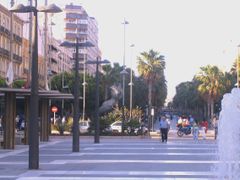
Transportation
By land, Almería can be reached by the A-7 Mediterranean Highway, which connects the Mediterranean area with the Spanish A-92 that unites it with the rest of Andalusia.
By sea, the port of Almería has connections to Melilla, Algeria and Morocco, and also tourist cruises in the Mediterranean. It also has a marina with moorings for pleasure boats. Currently the port of Almería is being expanded with new docks and transformed into a container port to take large-scale international shipping and thereby increase its freight traffic. It normally connects with the following destinations:
- Trasmediterranea: Ghazaouet (Algeria), Oran (Algeria), Nador (Morocco). and Melilla.
- Comarit: Nador.
- Comanav: Nador.
By air, Almería is served by Almería International Airport which is the fourth largest in Andalusia and has domestic and international flights, mainly to Amsterdam, Madrid, Barcelona, Melilla, London, Manchester, Birmingham, Brussels, Dublin and Swiss, German and other EU cities.
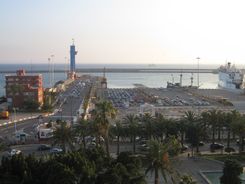
Geography
Due to its arid landscape, numerous spaghetti westerns were filmed in Almería. According to Christopher Frayling, the author of Once Upon A Time in Italy: The Films of Sergio Leone, some of the sets are still there.[3] These sets are located in the desert of Tabernas. The town and region were also used by David Lean in Lawrence of Arabia (1962), John Milius in The Wind and the Lion (1975), and others. One of Almería's most famous natural spots is the Cabo de Gata-Níjar Natural Park. This park is of volcanic origin, and is the largest and most ecologically significant marine-terrestrial space in the European Western Mediterranean Sea. With one of the most beautiful and ecologically rich coasts of the western Mediterranean and an area of 380 square kilometres it is one of Spain’s natural jewels. The Cabo de Gata Natural Park runs through the municipal areas of Níjar, Almería and Carboneras. Its villages, previously dedicated to fishing, have become tourism spots for those interested in nature. One of the greatest attractions of the Cabo de Gata Natural Park is its beaches.
Climate
Almería has a Subtropical climate, borderline semi-arid climate with Mediterranean influences. This is one of the sunniest, warmest and driest climate in Europe. It experiences the warmest winters of any European city with a population over 100,000 with average temperature of 17.5 °C (63.5 °F) during the day and 8.8 °C (47.8 °F) at night in the period December-January-February. Almería enjoys about 3000 hours of sunshine annually with around 320 sunny days a year on average (6 hours of sun in January and 12 in August). Almería has an average annual temperature of about 19 °C (66 °F) and on average only 25-30 wet days a year. During the winter, daily maximum temperatures tend to stay around 16–22 °C (61–72 °F). At night, the temperature rarely drops below 8 °C (46 °F). Precipitation falls in short heavy bursts. During the warmest month - August, the sky is clear and sunny and no rainfall occurs. The typical daily temperatures range from 30–36 °C (86–97 °F) and occasionally climb higher to around 40 °C (104 °F). The minimum temperatures stay well above 20 °C (68 °F).
| Climate data for Almeria (airport) | |||||||||||||
|---|---|---|---|---|---|---|---|---|---|---|---|---|---|
| Month | Jan | Feb | Mar | Apr | May | Jun | Jul | Aug | Sep | Oct | Nov | Dec | Year |
| Average high °C (°F) | 16.9 (62.4) |
17.7 (63.9) |
19.2 (66.6) |
21.0 (69.8) |
23.6 (74.5) |
27.3 (81.1) |
30.3 (86.5) |
30.7 (87.3) |
28.3 (82.9) |
24.3 (75.7) |
20.4 (68.7) |
17.9 (64.2) |
23.1 (73.6) |
| Daily mean °C (°F) | 12.5 (54.5) |
13.2 (55.8) |
14.7 (58.5) |
16.4 (61.5) |
19.1 (66.4) |
22.7 (72.9) |
25.7 (78.3) |
26.4 (79.5) |
24.0 (75.2) |
20.0 (68) |
16.2 (61.2) |
13.7 (56.7) |
18.7 (65.7) |
| Average low °C (°F) | 8.2 (46.8) |
8.8 (47.8) |
10.1 (50.2) |
11.9 (53.4) |
14.6 (58.3) |
18.2 (64.8) |
21.1 (70) |
22.0 (71.6) |
19.6 (67.3) |
15.7 (60.3) |
12.0 (53.6) |
9.4 (48.9) |
14.3 (57.7) |
| Precipitation mm (inches) | 23 (0.91) |
21 (0.83) |
15 (0.59) |
20 (0.79) |
14 (0.55) |
10 (0.39) |
1 (0.04) |
1 (0.04) |
12 (0.47) |
28 (1.1) |
28 (1.1) |
23 (0.91) |
196 (7.72) |
| Avg. precipitation days (≥ 1 mm) | 3 | 3 | 3 | 3 | 2 | 1 | 0 | 0 | 1 | 3 | 3 | 3 | 26 |
| Sunshine hours | 191 | 191 | 228 | 250 | 299 | 322 | 338 | 312 | 257 | 221 | 187 | 176 | 2,965 |
| Source: Agencia Estatal de Meteorología[4] | |||||||||||||

Films
List of films shot in Almería
Sister cities
Crystal Cave
In 2000, a team of geologists found a cave filled with giant gypsum crystals in an abandoned silver mine near Almería. The cavity, which measures 1.8x1.7 metres, would be the largest geode ever found. The entrance of the cave has been blocked by five tons of rocks, and is under police protection (to prevent looters from entering). According to geological models, the cave was formed during the Messinian salinity crisis 6 million years ago, when the Mediterranean sea evaporated and left thick layers of salt sediments (evaporites). The cave is currently not accessible to tourists.
See also
- Solar Almeria Platform
References
- ↑ Abella, Rafael La vida cotidiana durante la guerra civil: la España republicana. p.254 Editorial Planeta 1975
- ↑ http://www.congreso.es/consti/elecciones/referendos/ref_and_80.htm
- ↑ http://www.npr.org/templates/story/story.php?storyId=4780340
- ↑ "Valores Climatológicos Normales. Almeria / Aeropuerto". http://www.aemet.es/es/elclima/datosclimatologicos/valoresclimatologicos?l=6325O&k=and.
External links
- TourSpain Almeria
- (English) Smart Insider Travel Guide to Almeria
- (Spanish) Ayuntamiento de Almería
- (Spanish) Almería, Historia y Turismo
- images and information about the Almería area
- Maps of Almería
- (Spanish) Almería Football Club
- "Almería's History"
- Almeriaclips - Videos musicales rodados en Almería - Music videos shot in Almería
- (Spanish) Almería - Diputación Provincial de Almería
- (Spanish) Cabo de Gata - Níjar Natural Park
- Businesses of Almeria
|
|||||||
|
|||||

